Collection – “Emergency Measures”
(Chicago Historical Society & Northwestern University 2011)
This collection of documents aims to capture a variety of emergency measures that were taken in the immediate aftermath of the fire. The collection of eight sources ranges from copies of notices and ordinances to images of temporary badges used by police, as well as a look into temporary buildings that were used for authoritative purposes in the days and weeks following the fire.
“To the Homeless” (#8)
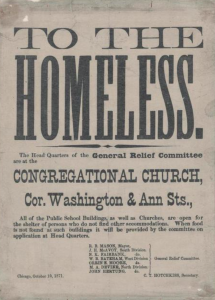
First, there is a copy of a notice titled “To the Homeless” that indicated where they were to go for temporary shelter. With the destruction of most of the downtown area, many essential buildings burned down in the fire and were given temporary locations in the days following. For instance, according to this notice from six days after the fire, the headquarters of the General Relief Committee could be found at the Congregational Church at the corner of Washington and Ann Streets. Additionally, at the bottom of the page is information regarding shelter at public schools and churches for people who were unable to find other accommodations, along with details about where they could find food.
“No Smoking; Manuscript Order” (#7)
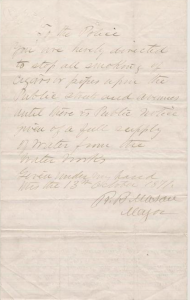
A second document in the collection is a manuscript from October 13, 1871, just three days after the fire ceased. Mayor Mason’s handwritten letter to the police is a directive banning cigars and pipes until Chicago’s water service could be restored. Anyone that was caught lighting a match or smoking a cigar on the street would face a hefty fine, as smoking was forbidden after this great fire had wreaked havoc throughout the city.
“Thieves and Burglars!” (#4)
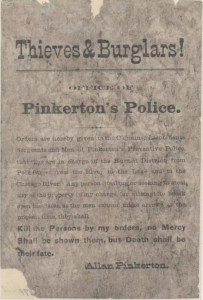
Another document included in the collection is an order from Allan Pinkerton, one of the men who entered the business of providing private security and armed force (see “Narrative” section) in the weeks following the fire. The document serves as a warning to anyone considering looting or rioting, or any action that is considered to be taking advantage of the post-fire situation.
The order lays out the situation at hand, that “Sergeants and Men of Pinkerton’s Preventative Police are in charge of the Burned District from Polk Street, from the River to the Lake and to the Chicago River. Any person Stealing or seeking to steal any of the property in my charge, or attempt to break open the Safes, as the men cannot make arrests at the present time, they shall Kill the Persons by my orders, no Mercy Shall be shown them, but Death shall be their fate.”
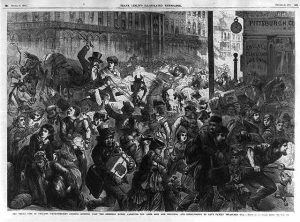
Outbreaks of chaos, looting, and lawlessness ensued in the immediate aftermath of the fire as people stampeded out of the city to get away from the flames
In attempting to prevent looting or any attempts at stealing of any sort, these men were ordered to kill anyone that does so. Evidently, the elites in charge of safeguarding private property were not messing around with the chaos in the streets.
“First Congressional Church” & “Badge Used by Special Police” (#2 & #3)
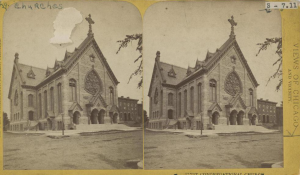
Two of the sources in the collection are images depicting two temporary changes in the immediate aftermath of the fire. As aforementioned, many of the city’s most prominent buildings burned to the ground in the fire, thus, they needed temporary “headquarters” for many of these organizations. The First Congregational Church at the corner of Washington and Ann Streets, as aforementioned and pictured in this stereograph became a temporary site for the seat of government both while the fire continued to burn and in the days after the fire had finally concluded.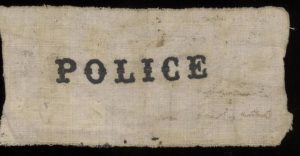
The second of the artifacts in the collection that provides a glimpse into the temporariness of the city after the Great Fire is a cloth badge that was used by the “special police’, who were essentially citizens (see “Narrative” section) that were sworn in to assist in law enforcement amid the disaster.
